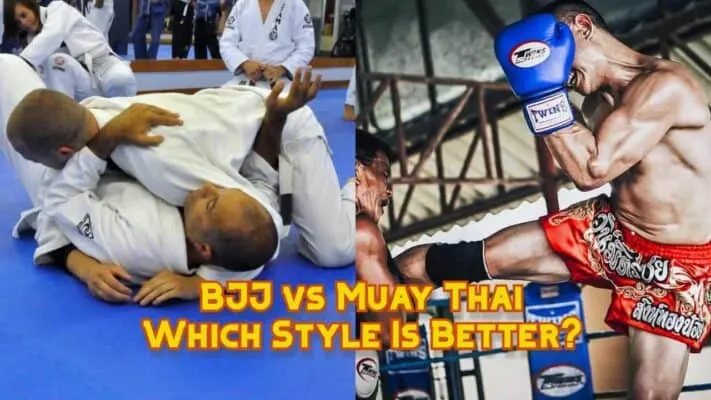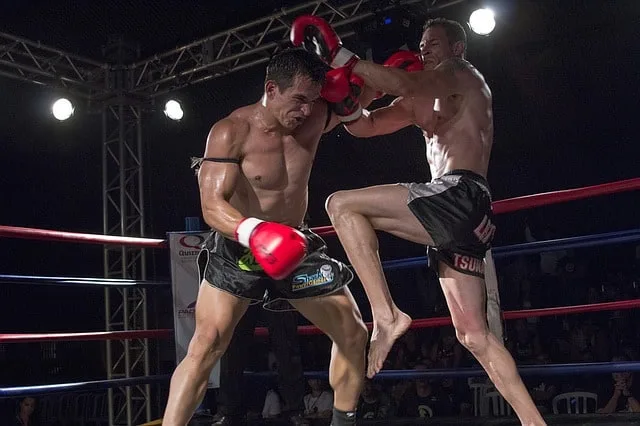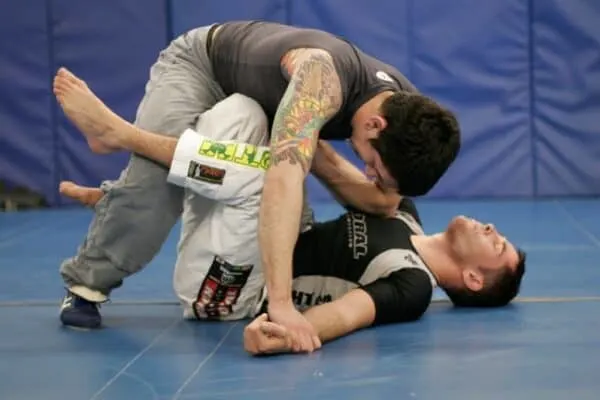
Brazilian Jiu-Jitsu(BJJ) is one of the most popular martial arts specializing in grappling and ground fighting. Muay Thai, on the other side, is often seen as a complete package when it comes to striking. The only thing these two arts share in common is the fact that both systems are highly effective in real combat, but which one is better?
BJJ focuses on grappling techniques similar to wrestling, whereas Muay Thai focuses on stand-up fighting using hard strikes. As a general rule, BJJ is better for self-defense and for people who are weaker and/or smaller, whereas Muay Thai is better for people who are taller with a reach advantage.
Saying which one is absolutely better is not an easy task as BJJ and Muay Thai each specialize in two separate worlds of fighting. To get the right answer, let’s see how these two systems compare when it comes to self-defense, MMA and many other aspects. Let’s go!
BJJ vs Muay Thai – Key Differences
BJJ and Muay Thai differ a lot in just about every aspect. Here is a list of all the major differences:
History
BJJ emerged in the 1920s in Brazil and its origins come from Judo. Its story has begun when a judoka, Mitsuyo Maeda, arrived from Japan to spread the sport of Judo in Brazil. The two of his most loyal students, brothers Carlos and Helio Gracie would later use judo as a base to develop BJJ.
Muay Thai comes from Thailand and its origins go all the way back to the 14th century and the art called “Muay Boran”. Siamese soldiers used to train in Muay Boran to improve hand-to-hand combat abilities. Later on, King Rama V, who was a big fan of Muay Boran, decided to legalize these matches and change the name to “Muay Thai”.
Concept
BJJ is one of the most effective martial arts designed with self-defense in mind. The emphasis is on ground fighting utilizing throws, positions, chokes, and joint locks. There are so many variables and it is so complex that people often refer to it as a “human chess match”. Instead of using sheer force, BJJ is known as a “gentle art” where athletes must be methodical, patient, and think three steps in advance.
Muay Thai is widely regarded as the most effective striking martial art one can train in. It will teach you all about the mental and physical aspects of fighting, and how to use all limbs as weapons to deliver powerful strikes. Though it is very practical in real life, Muay Thai as a concept remains a popular combat sport where people fight for money, fame, and glory.
Emphasis
The entire emphasis in BJJ is on grappling and you won’t learn any offensive or defensive striking techniques. The primary objective of BJJ is to close the distance, and execute a takedown to advance to the ground. Once on the ground, the goal is to get into one of many dominant positions, and place a choke or joint lock to submit the opponent.
The emphasis in Muay Thai is on hard kicks from the distance, and fighting inside the clinch with brutal knee and elbow strikes. It also involves punches, but those are not as important as kicks and clinch fighting. Students also learn basic trips, throws, and sweeps which they can use to take the opponent down. But, they are not allowed to fight on the ground or hit the grounded opponent. While BJJ is more methodical, Muay Thai is more intense as it emphasizes aggression and doing as much damage with every strike.
Techniques
BJJ is the most versatile grappling system that consists of dozens of different types of techniques like:
- Takedowns – double/single leg takedown, low single, angle pick
- Throws – Tomoe Nage, Uchi Mata, sumi gaeshi
- Dominant positions – full/back mount, side control, half-guard, crucifix
- Chokeholds – rear-naked choke, arm triangle, triangle choke, anaconda choke, americana
- Joint locks – kimura, armbar, kneebar, leg lock
Muay Thai is also known as “the art of eight limbs” because fighters are allowed to strike with:
- Kicks — roundhouse, front kicks, sidekicks, spinning kicks
- Punches — jab, cross, hook, uppercut
- Knees — straight knee, horizontal knee, curved knee, diagonal knee, flying knee
- Elbows — downward elbow, spinning elbow, horizontal elbow, uppercut elbow
- Execute various types of trips, sweeps, and throws
BJJ vs Muay Thai – Which martial art is better for self-defense?
One thing that BJJ and Muay Thai share in common is the fact that both of these arts are very effective for any type of freestyle combat. But which one is better for self-defense and why?
Muay Thai is a total package when it comes to striking. Though it is a combat sport where there are strict rules, Muay Thai will train both your mind and body for real combat. Classes are intense, there is a lot of hard sparring, and the emphasis is on aggression, power and damage. There is no playing around with doing katas, or learning how to score points and win decisions. No, Muay Thai is all about the pressure, launching power shots, and knocking the opponent out cold. It can be a very violent striking art.

It is very practical both in the open space where you can destroy the attacker with vicious kicks, or at close range where Thai boxers shine with the brutal clinch game. Even if the attacker tries to grapple, most Thai boxers are skillful enough to stop all types of trips, throws, and takedowns.
BJJ might be even better simply because of the fact that most people, including trained strikers, don’t know how to grapple. Throwing or blocking a strike is a natural reaction. But defending grappling attacks is all about leverage and technique and requires skill and years of training. This gives you big advantage in a fight, including against physically much bigger attackers.

Photo by Matthew Walsh
BJJ is the winner of this debate because it is a more efficient system when it comes to self-defense. Also, it allows you to neutralize the attacker without causing any serious injuries. Most people who take on trained Muay Thai fighters end up looking like they have survived a head-on crash.
BJJ or Muay Thai – Which one is better for MMA?
BJJ and Muay Thai both play a big role in modern cage fighting. On one side, BJJ skills are the most important aspect of the grappling game, while Muay Thai is often seen as a total package for MMA when it comes to striking. Since these two arts are fundamentally different and cover different aspects of the sport, the only fair answer is that BOTH are equally important.
You can’t expect to succeed in MMA without having, at least average defensive BJJ skills. All MMA fighters who are serious about their career must know the procedures how to stop the takedown, escape from a bad position, or submission on the ground. Sooner or later, the lack of ground game would catch up on you.
The same stands for Muay Thai. You can be the best grappler in the world, but being a one-dimensional fighter would backfire on you in a very, very painful way once you end up in a cage with a skilled striker.
BJJ vs Muay Thai – Who wins?
In theory, BJJ fighters have the upper hand because it is much easier for them to deal with strikes than it is for a Muay Thai fighter to stop a grappling attack. In reality, the outcome of a street fight between BJJ and Muay Thai fighters that share the same level of proficiency is very hard to predict. The only way to find a close answer is to see how the fighters from both arts would perform at different ranges.
Distance/open space
Muay Thai fighters need the space to operate and their best chances of winning come if the fight is in the parking lot or any other open space area. This allows them to utilize footwork to circle around, keep their range, and demolish BJJ fighters from the distance with kicks. But bear in mind that throwing wild kicks, like the ones targeting the body, can quickly backfire as this leaves them open for a takedown. On the other side, BJJ fighters won’t feel comfortable at this range at all as they might have a hard time closing the distance and taking the fight to the ground.
Clinch
Clinch position is very important for this debate as it is the place where most BJJ vs Muay Thai street fights would probably end up as both fighters feel comfortable here. On paper, BJJ has a big advantage in the clinch, but grapplers may get caught with a powerful elbow to the face, or a knee to the liver or other part of the body that can instantly cause serious pain or injury upon landing. Here is a brief look into a couple of different clinch positions this fight may end up in:
- Thai clinch is a position that gives a Thai boxer a big advantage. It allows them to unload with a barrage of knees to the head and body, without having to worry too much about grappling attacks. The only way BJJ fighter could escape from here is to execute a trip or throw.
- Single collar tie is also a position that favors Thai fighters. From here, they can unload with vicious elbows, knees, and execute sweeps. But BJJ fighters can counter with flying submissions like armbars and triangles.
- Underhook — is a clinch hold used primarily to control the opponent. From here, Thai boxers can throw a powerful elbow to the side of the head, or a knee to the thigh. BJJ fighters have the advantage here and would probably go for a trip/takedown.
- Over-under — is a position that favors BJJ fighters as they can use this position to quickly pull guard and advance the fight to the ground. On the other side, this is a terrible position for Thai boxers because they can’t do much from here.
Ground
BJJ is all about fighting on the ground while Muay Thai focuses on striking, so the conclusion is clear. Once the fight hits the ground, it would be a matter of seconds before a BJJ fighter gets into one of many dominant positions and sets up a submission.
RECOMMENDED FOR YOU: Grappling vs Striking – Which is More Effective?
BJJ vs Muay Thai – Which one is better for fitness?
Both BJJ and Muay Thai have a lot to offer when it comes to the health and fitness benefits. Training is a full-body workout that involves various aerobic and anaerobic workouts. It is one of the rare activities that allow you to improve strength and endurance at the same time. Which one is better really comes down to personal preferences.
Muay Thai is one of the most cardio intense martial arts and training will push both your mind and body over the limits on a daily basis. Most gyms put a lot of emphasis on endurance, so expect to do a lot of grueling cardio workouts like long-distance running, sprints, and rope jumps. They also do strength exercises but tend to focus more on the core and lower body segments because this increases the power of kicks, the main weapon in Muay Thai. On average, students can burn more than 500 calories per hour of training, which is a lot. This is why all Muay Thai fighters have low body fat index, look ripped, and have nice muscle tone.
BJJ shares similar benefits but focuses more on the core and upper body strength. Rolling on the mats with a person similar to your size or physically bigger is exhausting and will activate every single muscle group in your body. If you decide to join the BJJ classes, expect to exit the school crawling on all fours after each class in the opening month. Apart from core strength and overall conditioning, BJJ will improve your flexibility and range of motion.
RECOMMENDED FOR YOU: Why Are BJJ Classes So Expensive? Simply Explained
BJJ vs Muay Thai – Which one is harder to learn?
In order to determine which one is harder to learn, BJJ or Muay Thai, let’s look at how these two compare in the following aspects:
Technically more difficult — BJJ
BJJ is a complex grappling system that is technically more difficult than Muay Thai. There are dozens of different throws, positions, submissions, escapes, and many other techniques one needs to master and learn how to combine together. On top of that, it takes a lot of time to develop coordination, balance, and learn how to distribute weight during the grappling exchanges. Muay Thai is a versatile striking system but is not technically as difficult as BJJ.
More intense — Muay Thai
A very small number of martial arts or combat sports are as intense as Muay Thai. The action in BJJ is a bit slower, more technical, and fighters tend to be more strategic in their approach. Muay Thai, on the other side, is all about speed, power, damage, deep cuts, broken bones, and knockouts. Training is a mix of grueling cardio and strength workouts, throwing hundreds of strikes, hard sparring, and all while having very little rest.
Takes longer to learn: BJJ
As a more complex martial art, BJJ takes more time to master. In fact, on average, BJJ students need to spend between 10 to 15 years of training hard to reach a black belt rank. The other reason why the progress is slow is the fact that BJJ includes a strict promotional criteria. Muay Thai also takes a lot of time, but most people with average talent could master it in around 3 years. In BJJ, you would be transitioning from beginner to intermediate techniques at this stage.
Higher injury rate: Muay Thai
Thai boxing is a brutal sport that has a much higher injury rate than BJJ. Even in training, people get injured all the time simply because all schools put a lot of emphasis on hard sparring as the best method one can prepare for real combat. Some of the most frequent injuries are also some of the most serious ones like concussions, leg and rib fractures, broken noses, sprained or fractured wrists, torn ACL’s, and many, many other.
BJJ on the other side doesn’t include striking at all which makes it far less dangerous than Muay Thai. But as in any other sport, people can get hurt.
RECOMMENDED FOR YOU: Which Martial Art Has The Most Injuries? FAQs
Should I train BJJ and Muay Thai at the same time?
Training both BJJ and Muay Thai at the same time is great and has many benefits. In the end, these two martial arts complement each other in many ways. Fighters who regularly train in both gyms are actually MMA fighters looking to develop their all-around game.
If you have time to regularly visit both gyms, you can learn BJJ and Muay Thai at the same time without question. These two systems are totally different which actually a good thing is because training in Muay Thai won’t mess with your BJJ progress, and vice versa. However, as a beginner, you should focus on becoming good at one martial art first before you start cross-training. Starting both from scratch will slow down your progress a lot.
